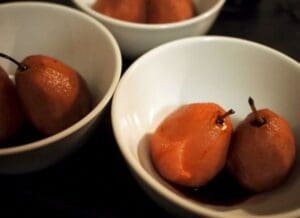Poaching: What It Is and What Foods to Poach

When the weather just starts to chill, it’s the perfect time for poaching–a cooking technique ideal for autumn. It’s a light, delicate way to cook seasonal fall foods, and a perfect balance to the high-heat roasting you’re probably already doing in the kitchen. Consider: poached pears with vanilla and cinnamon, chicken breasts with tarragon and cream sauce, wild salmon with shiitake mushrooms, or filet mignon with horseradish. Here’s a bit on how to poach, and which foods to try.
What is poaching?
Poaching is a delicate way of cooking something by only slightly submerging it in gently simmering water. The cooking pan is usually covered—or partially covered—so that steaming helps to cook the food. This mixture of steaming and simmering results in moisture-rich, soft foods with a mild flavor.
The poaching liquid
Your food—be it a whole pear or a pair of chicken breasts—should be cooked in a high-edged sauté pan that’s filled just with enough liquid to partially submerge them, usually about halfway up the sides of the food. Your poaching liquid can be as basic as plain salted water, though it’s usually seasoned.
For savory dishes, a mixture of vegetable or chicken broth, fresh herbs, or chopped vegetables may be used as/in the poaching liquid. For sweet dishes, apple or fruit juice may be employed, as well as winter spices or ginger. In either case, a splash of acid (e.g., lemon or white wine) added to the cooking liquid adds balance to the flavors.
Some of the food’s flavor will be released into the cooking liquid as it poaches, so it’s often a good idea to reduce your poaching liquid into a sauce (or “reduction”) once the food is cooked and removed. This is especially great if you’ve included herbs, spices, or chopped vegetables in the poaching liquid; once you reduce that liquid, all those key flavors will become concentrated into your pan sauce.
The poaching method
Place the food to be poached inside your cooking pan. Add poaching liquid into the pan until the liquid comes up no more than halfway up the sides of the food. Partially cover the pan with a lid. (Alternatively, you can cut a circle out of parchment paper the size of the lid, and place that atop the pan as your cover.)
Bring the liquid up to a simmer and immediately lower to a gentle simmer. Continue cooking until your food inside is done. To make a reduction sauce, first remove your cooked food from the pan; then boil it down rapidly until it reaches sauce consistency. At this step you may choose to add olive oil or butter to the sauce to thicken it and give a flavorful “sheen.” Season the sauce and pour it over your poached food.
What foods to poach
The most common sweet foods to poach are fall fruits like apples, pears, figs, and oranges. For savory dishes, thick fish fillets like salmon, cod, or swordfish, or chicken are common standbys. Try our recipe for Pomegranate Poached Pears or Poached Organic Christmas Pears in Port Wine Sauce for a sweet poached treat today.
Image adapted from Alex S. Bayley, Flickr, Creative Commons 2.0










